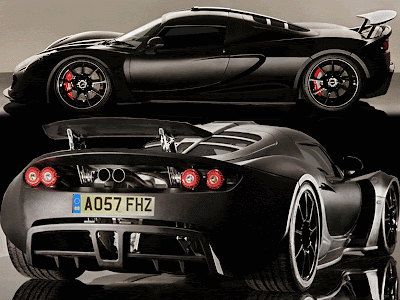
Mercedes-Benz introduced a new race car during the New York Auto Show earlier today. The Mercedes-Benz SLS AMG GT3 will be used in competition beginning in 2011.
The 2011 Mercedes SLS AMG GT3 is powered by the AMG 6.3-litre V8 front-mid engine with dry sump lubrication coupled with a sequential six-speed racing transmission steering wheel shift paddles. The 2011 Mercedes SLS AMG GT3 also comes with an multi-disc locking differential integrated in the
transmission. The engine and the transmission of the 2011 Mercedes SLS AMG GT3 are connected via a torque tube within which a carbon-fiber shaft rotates at the engine speed, as in the roadgoing version.
The SLS AMG GT3 features a new new front apron with a splitter, the bonnet with central cooling air vent, wider front and rear wings, sideskirts with cooling ducts for the rear brakes, a rear diffuser and the adjustable rear aerofoil.
That light-weight body is made entirely of carbon fiber, with impressive new aerodynamics including a massive front splitter, rear diffuser and enormous rear spoiler. Compared to the road car, the GT3’s bodywork is two inches wider, enough to accommodate some massive center locking 18×12-inch front and 18×13-inch rear wheels with racing slicks. Inside those wheels is a special composite AMG race braking system with six-piston front calipers and four-piston rear calipers.
The 2011 Mercedes SLS AMG GT3 price was not announced yet, but Daimler mentioned that sales will start in autmun 2010.
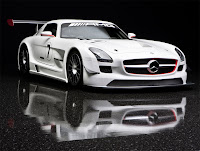

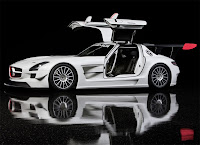
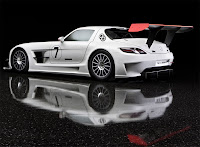
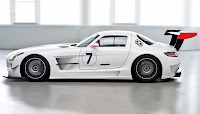


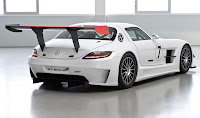

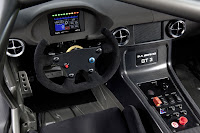


Press Release
Automobile fascination paired with spectacular race car design - that is the new Mercedes-Benz SLS AMG GT3. The racing version of the SLS AMG has been conceived as a customer sport vehicle for participation in race series based on FIA GT3 regulations. Meticulous lightweight construction and optimized chassis, brakes and aerodynamics deliver uncompromising dynamics. The extra special SLS AMG will make its race track debut in 2011.
The clean design and breathtaking form of the SLS AMG have been effectively accentuated by targeted modifications to the bodyshell. The new components, made largely from lightweight carbon fiber offer a clear indication of extraordinary race track performance and extensive aerodynamic development work.
From the front, the GT3 race car boasts a new front skirt with enlarged air intakes. The wide opening beneath the characteristic radiator grille bearing the large Mercedes star and the wing-shaped horizontal fins supplies air to the engine oil cooler and brake discs. The same function is served by the two intakes below the vertical bi-xenon headlamps. Downforce on the front axle is provided courtesy of four externally mounted side flics, as well as a carbon front splitter; it runs directly into the smooth underbody panel, which connects to the rear diffuser.
The hood features a central opening for the extraction of heat from the engine, while side openings in the front fenders facilitate air flow through the wheel arches. Weight optimization measures include the application of extremely lightweight polycarbonate for the side and rear windows and, if desired, for the front windshield as well.
The fenders have been widened front and rear to accommodate the large racing tires. With a breadth of 78.3 inches, the GT3 bodyshell is a good 2 inches wider than the series production SLS AMG. The new sills feature openings for cooling the rear brakes, with the smooth underbody visible along the underside of the sills. The B-pillar houses the standardized fuel tank adapter for the rapid refueling system. The 31.7 gallon fuel tank is located centrally behind the driver.
Wide rear carbon spoiler
The rear view of the SLS AMG GT3 is dominated by its imposing width. Above the rear hatch sits a wide carbon fiber spoiler; it is extensively adjustable and facilitates perfect setup to suit individual race track characteristics. The new rear skirt accommodates two openings for extracting air from the rear wheel arches. A further visual highlight is the rear carbon fiber diffuser; it rises smoothly from the rear axle area as a continuation of the smooth underbody, its form adding to the downforce. The overall aerodynamic concept of the SLS AMG GT3 was analyzed and defined through extensive wind tunnel and race track testing.
The black exhaust end pipes deliver a fascinating and, at the same time, characteristic AMG eight-cylinder sound. The regulation rain lamp is integrated into the rear hatch - it must be switched on by the driver in poor weather conditions.
Close to series production AMG 6.3 liter V8 engine
As defined in the FIA GT3 regulations, the AMG 6.3 liter V8 engine is virtually identical to that of the series production vehicle. Thanks to its low weight, the acceleration figures for the GT3 - 3.7 seconds for the sprint from 0 to 60 mph - are considerably below the already excellent figures for the series production vehicle. Depending on gear ratio, the top speed is more than 186 mph.
The AMG 6.3 liter V8 engine uses dry sump lubrication in the racing vehicle, too. The application of a suction and pressure pump, as well as an external oil tank means that the conventional oil sump can be omitted. This technology ensures reliable lubrication of the engine under high lateral acceleration, of the kind usually experienced on the race track.
Dry sump lubrication also facilitates a low mounting position for the V8 power unit - one of the key technological highlights of the SLS AMG. The solution - installing the eight-cylinder as low as possible and as a front mid engine behind the front axle, combined with a transaxle transmission layout - results in excellent weight distribution.
Six-speed racing transmission with sequential shift
In contrast to the series production vehicle, the SLS AMG GT3 is equipped with a six-speed racing transmission with sequential shift. Thanks to its compact construction, the race-tested transmission offers considerable packaging benefits - ultimately, the GT3 version has less ground clearance than the series production vehicle. The driver shifts gear using two shift paddles on the steering wheel. The transmission is mounted directly on the rear axle and connected to the V8 engine via a torque tube, which has a very high degree of flexural and torsional stiffness. This delivers considerable benefits when it comes to dynamics, as this sophisticated solution enables the entire driveline to be laid out with significantly less play. Alongside the traction control, a multi-plate locking differential integrated into the transmission delivers outstanding acceleration characteristics. Inside the torque tube, a drive shaft rotates at engine speed. As in the series production model, and in the Mercedes-Benz C-Class DTM touring car, the shaft is made from carbon fiber.
With its long wheelbase, low center of gravity and wide track, the SLS AMG vehicle concept was predestined for the race track - its strengths include precise turn-in characteristics, first-class agility, low inertia under sudden changes of direction and a high cornering limit.
It required only minimal modification for perfect race track performance. The lightweight aluminum chassis with double wishbone suspension at all four corners has modified kinematics to take into account the lower vehicle height. The array of adjustability options facilitates optimal modification to suit individual race track characteristics and varying weather conditions. As well as the ability to vary the spring and damper setup, there is also the freedom to adjust track and camber, vehicle height and the stabilizers on the front and rear axles.
Like the series production SLS AMG, the GT3 version is also equipped with rack and pinion steering with speed-dependent power assistance. The more direct input ratio facilitates even greater handling agility on the race track.
AMG race braking system using composite technology
Shortest stopping distances, highest stability and optimal control are guaranteed by the AMG race braking system. All four corners feature brake discs in motorsport-tested composite technology. Gray cast iron axial and radial floating discs are fixed to an aluminum hat via stainless steel composite elements. This sophisticated technology enables perfect heat dissipation and thus reliable stability. The SLS AMG GT3 is also equipped with precisely calculated cooling channels - openings in the front skirt and ahead of the rear wheels direct cool airflow over the brake discs. All four brake discs are ventilated, slotted and drilled. Six-pot fixed calipers on the front axle and four-pot fixed calipers at the rear, finished in anthracite with the AMG logo in white, provide plenty of brake pad surface. An anti-lock brake system with special race track settings is fitted as standard. Due to space restrictions, the AMG high-performance ceramic composite brake system, available as an option on the series production vehicle, is not compatible with the 18-inch wheels prescribed by FIA regulations.
The AMG center-locking alloy wheels - 12x18 inches front and 13x18 inches rear - are fitted with racing tires in formats 11.3 x 26.9 inches (front) and 12.4 x 27.9 inches (rear). Depending on the application, the tires are available as profile-free slicks, intermediates or wet weather tires. The classic multi-spoke design aids ventilation of the braking system. Fast pit stops and wheels changes are ensured by the pneumatic lift system integrated into the underbody. Four pneumatic rams raise the GT3 race car by around 7.5 inches, enabling the pit crew to change the racing tires in double quick time.
Interior with racing bucket seat and race steering wheel
On opening the gullwing doors, the SLS AMG GT3 displays a functional interior with a distinctly race car feel. The driver sits in a racing bucket seat fitted with a six-point harness and the HANS system (Head and Neck Support) that fixes the helmet in place in the event of an accident, thus minimizing the risk of injury. Additional safety comes courtesy of the steel roll cage, which also serves to further stiffen the aluminum spaceframe.
A steering wheel with a diameter of 13 inches facilitates perfect vehicle control. Because it is open at the top, the driver always has a perfect view of the central display, which provides all relevant information such as road speed, engine speed, operating temperatures, lap times and gear selection. The steering wheel is fitted with a quick-release mechanism that makes entering and exiting the vehicle considerably easier. The switches on the steering wheel hub enable the driver to activate additional functions such as the pit radio, headlamp flasher and the drink supply. Further operating elements are mounted on the center console and include the start/stop function for the AMG V8 engine, the traction control, reverse gear and - just in case - the integrated fire extinguisher. The control for adjusting brake balance is located on the torque tube tunnel.
The close relationship between the GT3 and its series production sibling is demonstrated by the instrument cluster, with its powerfully taut wing profile providing visual breadth. Integrated into the dash are the highly distinctive air vents galvanized in "Silver Shadow" and with adjustable cross-shaped nozzles - their form evocative of a jet engine.
Deliveries of customer vehicles to start early 2011
The new SLS AMG GT3 has been developed in accordance with FIA GT3 regulations and is entitled to participate in all GT3 race series - including the popular 24-hour races in Spa-Francorchamps, Belgium, and on the Nürburgring in Germany. Interested customers can order the vehicle starting in autumn 2010, with delivery scheduled prior to the start of the 2011 racing season. Homologation will be completed in March 2011.














